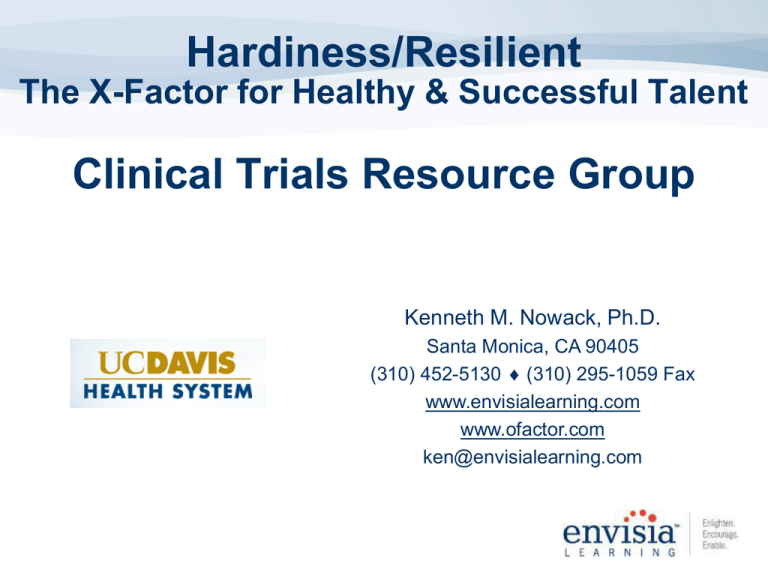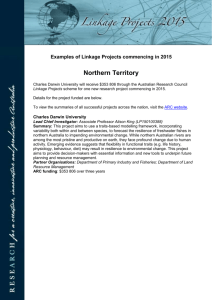Hardiness/Resilient Clinical Trials Resource Group The X-Factor for Healthy & Successful Talent
advertisement

Hardiness/Resilient The X-Factor for Healthy & Successful Talent Clinical Trials Resource Group Kenneth M. Nowack, Ph.D. Santa Monica, CA 90405 (310) 452-5130 (310) 295-1059 Fax www.envisialearning.com www.ofactor.com ken@envisialearning.com Kenneth M. Nowack, Ph.D. is a licensed psychologist and President of Envisia Learning, Inc. (www.envisialearning.com), a management consulting and publishing company and President of Ofactor Inc. (www.ofactor.com) a neuroscience consulting company. Dr. Nowack received his doctorate degree in Counseling Psychology from the University of California, Los Angeles and has published extensively in the areas of leadership development, assessment, health psychology, and behavioral medicine. Ken serves on Daniel Goleman’s Consortium for Research on Emotional Intelligence in Organizations and serves as Associate Editor for The Consulting Psychology Journal: Practice and Research. 1 Hardiness/Resilient The X-Factor for Healthy and Successful Talent The Secret to Happiness Our Research on Resilience Enhancing Resilience 2 The Secret to Happiness 3 Happiness Formula H appiness =G enetics 50% +C ircumstances 10% +I ntentions 40% Lyubomirsky, S., Sheldon, K. M., & Schkade, D. (2005). Pursuing happiness: The architecture of sustainable change. Review of General Psychology, 9, 111-131 4 Increasing Happiness Identify your “signature strengths” and use these weekly Become involved with others and volunteer Spend more time engaged with family and friends you find enjoyable Increase the amount of sleep you get to improve mood Reflect on three good things that made your day positive Practice forgiveness and gratitude giving Exercise at least 3-4 times a week to improve mood Seligman, M. et al., 2005. Positive psychology progress: Empirical validation of interventions. American Psychologist, 60, 410-421. 5 Charles Darwin Defining and Measuring Resilience 6 Five Basic Human Drives (Nowack, 2015) Approach/Avoidance Affiliation/Bonding Autonomy/Control Mastery/Growth Purpose/Hope 7 Stress Response (HPA Axis) Threat—Hindrance—Challenge Stressors 8 The “Force” Vs. The “Dark Side” Chronic Stress Decreases Activation of the Ventrolateral Prefrontal Cortex and Increases the Activation of the Amygdala 9 “It is not the strongest of the species that Charles Darwin survives, nor the most intelligent that survives. It is the one that is the most adaptable to change.” Charles Darwin 10 Definition of Resilience Resilience refers to positive adaptation or Charles Darwin the ability to maintain physical health and psychological well-being in the face of life adversity and challenge Herrman, et al., 2011 11 Resilience Inventory Stress Profile Scale (WPS; Nowack, 1996) A set of pervasive attitudes and beliefs that include: • • • • View change as a challenge, rather than a threat Are committed, rather than alienated, with their activities a work and home Possess a more internal, rather than external, locus of control Possess an optimistic explanatory style by appraising bad events as relatively external, unstable and specific WHAT HIGH SCORES MEAN High scores suggest a general optimistic attitude and sense of resilience compared to those with low scores IMPLICATIONS Hardy individuals who experience stress report significantly less illness, job burnout, and psychological distress 12 Resilience Inventory Interpretation 13 Enhancing Resilience 14 Developing Resilience Resilience Factors Neurobiological: Effective regulation of the hypothalamus-pituitary axis (HPA) to stress; Coaching Interventions Stress inoculation training (SIT); Mindfulness based stress reduction meditation Capacity to regulate limbic reactivity to stress and prefrontal executive function Physical Health: High quality and adequate Wellness/lifestyle management interventions quantity of sleep; Regular physical activity; Healthy nutritional habits Social: Satisfaction and utilization of one’s social support network; Strong social skills; Resilient role models 15 Enhancement of social and emotional competence (EI); Strengthening of social support networks Behavioral Approaches to Enhance Resilience 1. Sleep More 2. Increase Physical Activity 3. Develop/Strengthen your Social Support Network 4. Practice Gratitude 5. Fall Upwards/Post Traumatic Growth 16 Behavioral Approaches to Enhance Resilience 6. Develop a “Catastrophe” vs. “Annoyance Mindset 7. Be Hopeful and Optimistic 8. Move Towards Goals…Or Quit 9. Practice Forgiveness 10. Identify/Deploy “Signature Strengths” 17 “I want to die in my sleep like my Charles Darwin grandfather—not screaming and yelling like the passengers in his car.” Will Shriner 18 Three Stages of Resiliency 19 Resilience Goal Setting Options One Time—Sometime—All The Time (BJ Fogg, 2014) Step 1 Assess 360 Assessment Stop Doing 20 Do Step 2 Less Reflect/Plan Momentor Start Doing Do Step 3 More Do Differently Track/Monitor Coach Accelerator Resilience Exercise: My Success Scorecard 21 “Live each day as if it is Charles Darwin your last for one day it will be.” Unknown 22 Learning and Reflection What key learning did I get from today’s presentation? (What have I heard? / What have I learned?) How can I apply this new knowledge, information, or technique to a challenge at work? What specific actions am I committing to as a result of what I have learned? 23 Questions? 24






